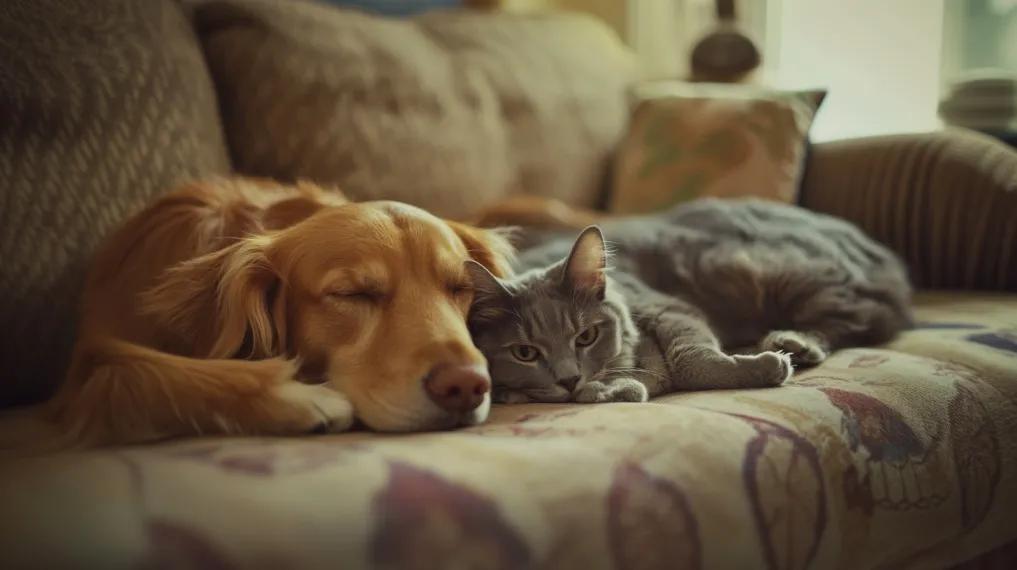How Pets Affect Indoor Air Quality: Tips for Managing Pet Dander

Most Americans consider their pets to be beloved members of the family. And why not? With their unconditional love and companionship, pets enrich our lives in countless ways.
However, pets can also present challenges, particularly when it comes to indoor air quality. Pets shed hair and dander, which can clog HVAC filters and impact the condition of your home’s air supply. By understanding how pets impact indoor air quality and implementing effective strategies, you can create a healthier environment for both your family and your furry friends.
How Do Pets Affect Indoor Air Quality?
Pets release something called pet dander, which is made up of tiny, microscopic skin flakes. These particles – which contain proteins that can cause allergic reactions – can become airborne and settle on surfaces, affecting everyone in the household.
Pet dander can be a real issue for the 10-20% of people who have allergies or asthma, but it can also affect those without these conditions by adding to the general indoor air pollution in your home. Along with cats and dogs, other pets with fur such as hamsters, guinea pigs, and ferrets can increase animal allergies, according to the Asthma and Allergy Foundation of America.
Pet hair on its own isn’t harmful, but it can collect dust, pollen, and other allergens, which can worsen your home’s air quality. Managing pet dander and keeping your home clean are key to reducing these issues and creating a healthier living space for everyone.
Tips to Improve Indoor Air Quality for Pet Owners
1. Clean Frequently
If you have cats, dogs, or other furry pets like rabbits and guinea pigs, you may already follow a regular cleaning routine. Frequently vacuuming floors, carpets, and upholstery helps remove pesky pet hair and dander. Consider using a vacuum with a HEPA filter to trap allergens, and wash pet bedding, toys, and fabrics your pet frequently comes into contact with such as bed sheets or throw rugs.
2. Grooming
To limit the spread of hair and pet dander throughout your home, make sure to groom your pets regularly. For dogs with longer coats, this might mean daily brushing and visits to the groomer every 4-6 weeks. Whenever possible, brush your pet outside to keep hair and dander out of your living areas, which helps reduce allergens and keeps your home cleaner. Also, bathe your dogs as needed to maintain their coat and limit buildup.
3. Install Air Purifiers
If you own pets, especially more than one, consider installing an air purification system. Air purifiers and air cleaners capture tiny particles including dust, dirt, allergens, and, yes, pet dander and hair. Consider installing a whole-house air purifier to provide filtration coverage for your entire home.
4. Change Air Filters Regularly
Air filters trap contaminants such as pet dander to prevent them from entering your HVAC system and circulating back into your living areas. You may need to change your air filters more frequently if you own pets. Check the condition of your filters once a month, and change them as needed.
5. Create Pet-free Zones
If you have pets and experience minor allergies, setting up a pet-free zone in your home can be beneficial. For example, designating your bedroom as a no-pet area can help reduce pet dander where you sleep, leading to better night’s sleep and a more refreshed feeling in the morning. If you prefer having Fido sleep beside you, just make sure to wash the sheets more frequently.
6. Ventilate Your Home
Ventilating your home can also improve air quality and reduce harmful contaminants like pet dander. Open windows when the weather allows to let fresh air in and clear out pollutants. Installing ventilation systems like air exchangers or exhaust fans can also help by constantly removing stale air and bringing in fresh air.
7. Use an Indoor Air Quality Monitor
If you’re worried about how pet hair and dander might be affecting your home’s air quality, consider buying an indoor air quality monitor. These handy devices provide useful information about the levels of pollutants, including pet dander, so you can keep track of allergens and make your living space healthier.
Managing Your Love of Pets with Clean Air
While pets bring joy and companionship into our lives, managing their impact on indoor air quality is crucial for a healthier home. By following these tips – like regular cleaning, grooming, and using air purifiers – you can enjoy the best of both worlds: the love of your pets and a cleaner, healthier living space.